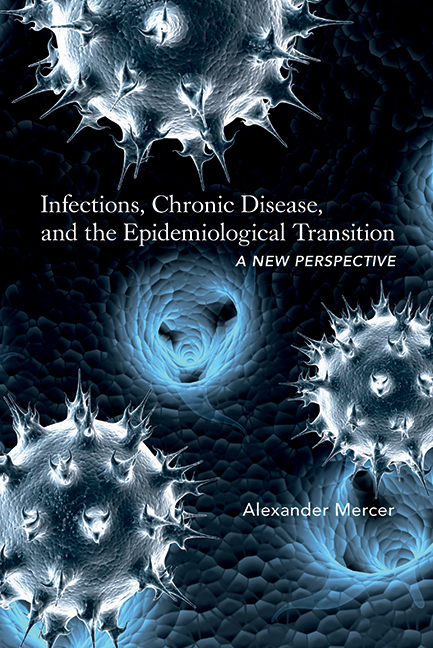Book contents
- Frontmatter
- Dedication
- Contents
- Preface
- Acknowledgments
- Introduction
- 1 Background
- 2 Theoretical Framework, Data, and Study Outline: The Concept of Epidemiological Transition
- 3 A New Infectious Disease Environment
- 4 Mortality Decline, Food, and Population Growth: “Standard of Living” and Nutrition
- 5 Smallpox
- 6 Typhus, Typhoid, Cholera, Diarrhea, and Dysentery
- 7 Infant Mortality
- 8 Child Mortality
- 9 Tuberculosis
- 10 Respiratory Diseases
- 11 Cardiovascular Disease
- 12 Cancer
- 13 Other Chronic Diseases
- 14 Epidemiological Transition: A New Perspective
- Appendixes
2 - Theoretical Framework, Data, and Study Outline: The Concept of Epidemiological Transition
Published online by Cambridge University Press: 14 March 2018
- Frontmatter
- Dedication
- Contents
- Preface
- Acknowledgments
- Introduction
- 1 Background
- 2 Theoretical Framework, Data, and Study Outline: The Concept of Epidemiological Transition
- 3 A New Infectious Disease Environment
- 4 Mortality Decline, Food, and Population Growth: “Standard of Living” and Nutrition
- 5 Smallpox
- 6 Typhus, Typhoid, Cholera, Diarrhea, and Dysentery
- 7 Infant Mortality
- 8 Child Mortality
- 9 Tuberculosis
- 10 Respiratory Diseases
- 11 Cardiovascular Disease
- 12 Cancer
- 13 Other Chronic Diseases
- 14 Epidemiological Transition: A New Perspective
- Appendixes
Summary
The original concept of “epidemiologic transition” outlined by Omran in 1971 focused attention on extremely important changes in cause of death. The infectious diseases that had caused very high mortality among children and adults in the past had been replaced as the main causes of death in industrialized countries by chronic diseases among adults assumed to be noninfectious in origin. There was much criticism of his concept as a “theory,” and it does appear simplistic in the light of subsequent findings about the etiology of chronic diseases. Patterns of disease, mortality, and life expectancy are more complex than a simple shift to predominantly chronic diseases as infectious disease mortality declined. Nevertheless, despite criticisms and revisions of the phases of “epidemiologic transition,” it has provided a framework for comparison of secular trends and profiles of disease in different populations. An objective of this study is to develop a perspective on historical changes in disease and mortality that goes beyond descriptive accounts of different phases of transition, takes into account disease etiology and the interrelationships between diseases, and contributes to an understanding of how contemporary patterns of disease have come about.
Omran's first formulation of his theory consisted of five propositions, which can be summarized as follows:
1. “Mortality is a fundamental factor in population dynamics.”
2. “A long-term shift occurs in mortality and disease patterns whereby pandemics of infection are gradually displaced by degenerative and man-made diseases as the chief form of morbidity and primary cause of death.”
3. “The most profound changes in health and disease patterns obtain among children and young women.”
4. “The shifts in health and disease patterns that characterise the epidemiologic transition are closely associated with the demographic and socioeconomic transitions that constitute the modernisation complex.”
5. There are three basic models of the “epidemiologic transition” corresponding to the experience of most Western countries, countries such as Japan where the transition was more rapid, and developing countries where the decline in mortality commenced more recently.
Information
- Type
- Chapter
- Information
- Infections, Chronic Disease, and the Epidemiological TransitionA New Perspective, pp. 19 - 33Publisher: Boydell & BrewerPrint publication year: 2014
